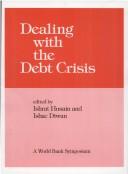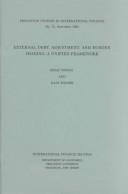| Listing 1 - 10 of 27 | << page >> |
Sort by
|
Book
ISBN: 9789814596008 9789814596015 9814596019 1306941911 9781306941914 Year: 2014 Publisher: Singapore : World Scientific,
Abstract | Keywords | Export | Availability | Bookmark
 Loading...
Loading...Choose an application
- Reference Manager
- EndNote
- RefWorks (Direct export to RefWorks)
For the millions of citizens in the Arab World who came together in 2010-2011 to discover their common yearning for dignity and liberty, the real revolutions only began after the wave of protests. Understanding the Political Economy of the Arab Uprisings reassess the interests, potential and constraints of various socio-political players and their importance in the building of a constructive environment for democratic progress in the Middle East. Initiated by the Cairo-based Economic Research Forum and edited by Ishac Diwan, this invaluable volume features contributions by Middle East academic
Arab Spring, 2010 --- -Arab Awakening, 2010 --- -Economic aspects. --- Arab countries --- Arab world --- Arabic countries --- Arabic-speaking states --- Islamic countries --- Middle East --- Economic conditions --- Politics and government
Book
Year: 1992 Publisher: Cambridge, Mass. National Bureau of Economic Research
Abstract | Keywords | Export | Availability | Bookmark
 Loading...
Loading...Choose an application
- Reference Manager
- EndNote
- RefWorks (Direct export to RefWorks)
Book
Year: 1989 Publisher: Cambridge, Mass. National Bureau of Economic Research
Abstract | Keywords | Export | Availability | Bookmark
 Loading...
Loading...Choose an application
- Reference Manager
- EndNote
- RefWorks (Direct export to RefWorks)
Book
ISBN: 1280004940 9786610004942 0585221324 Year: 1999 Publisher: Washington, DC : World Bank,
Abstract | Keywords | Export | Availability | Bookmark
 Loading...
Loading...Choose an application
- Reference Manager
- EndNote
- RefWorks (Direct export to RefWorks)

ISBN: 0821312464 Year: 1989 Publisher: Washington, D.C. World Bank
Abstract | Keywords | Export | Availability | Bookmark
 Loading...
Loading...Choose an application
- Reference Manager
- EndNote
- RefWorks (Direct export to RefWorks)
International finance --- Developing countries --- Debt relief --- Debts, External --- 339.727.2 --- -Debts, External --- -AA / International- internationaal --- LDC / Developping Countries - Pays En Développement --- 339.115 --- 338.340 --- 382.256 --- 336.311.2 --- 338.341.1 --- 382.254 --- 333.109 --- 339.727.2 Internationale kapitaalbeweging. Buitenlandse leningen. Buitenlandse kredieten. Internationale kapitaalbeweging. Buitenlandse investeringen. Kapitaalinvoer. Kapitaaluitvoer. Kapitaalvlucht --- Internationale kapitaalbeweging. Buitenlandse leningen. Buitenlandse kredieten. Internationale kapitaalbeweging. Buitenlandse investeringen. Kapitaalinvoer. Kapitaaluitvoer. Kapitaalvlucht --- Debt renegotiation --- Debt rescheduling --- Debt restructuring --- Relief, Debt --- Renegotiation, Debt --- Rescheduling, Debt --- Restructuring, Debt --- Debtor and creditor --- Debts, Foreign --- Debts, International --- External debts --- Foreign debts --- International debts --- Debt --- Investments, Foreign --- Buitenlandse schuld. Debt Equity Swap in LDC. --- Algemene ontwikkeling in de Derde Wereld. --- Buitenlandse hulp (betalingsbalans). --- Buitenlandse leningen van de overheid. --- Financiële hulp aan de Derde Wereld. --- Internationale kredieten. --- Veiligheid. Bankovervallen. Bankrisico's. --- Law and legislation --- AA / International- internationaal --- Veiligheid. Bankovervallen. Bankrisico's --- Buitenlandse leningen van de overheid --- Algemene ontwikkeling in de Derde Wereld --- Financiële hulp aan de Derde Wereld --- Buitenlandse schuld. Debt Equity Swap in LDC --- Internationale kredieten --- Buitenlandse hulp (betalingsbalans)

ISBN: 0881652458 9780881652451 Year: 1992 Volume: 73 Publisher: Princeton (N.J.): Princeton university. Department of economics. International finance section,
Abstract | Keywords | Export | Availability | Bookmark
 Loading...
Loading...Choose an application
- Reference Manager
- EndNote
- RefWorks (Direct export to RefWorks)
International finance --- Structural adjustment (Economic policy) --- Debts, External --- Debt relief --- Mathematical models --- -Debts, External --- -Structural adjustment (Economic policy) --- -LDC / Developping Countries - Pays En Développement --- 339.115 --- Economic policy --- Debts, Foreign --- Debts, International --- External debts --- Foreign debts --- International debts --- Debt --- Investments, Foreign --- Debt renegotiation --- Debt rescheduling --- Debt restructuring --- Relief, Debt --- Renegotiation, Debt --- Rescheduling, Debt --- Restructuring, Debt --- Debtor and creditor --- Buitenlandse schuld. Debt Equity Swap in LDC. --- Law and legislation --- LDC / Developping Countries - Pays En Développement --- Buitenlandse schuld. Debt Equity Swap in LDC --- Structural adjustment (Economic policy) - Mathematical models --- Debts, External - Mathematical models --- Debt relief - Mathematical models
Book
ISBN: 1137583940 1137529768 1137529776 Year: 2016 Publisher: London : Palgrave Macmillan UK : Imprint: Palgrave Macmillan,
Abstract | Keywords | Export | Availability | Bookmark
 Loading...
Loading...Choose an application
- Reference Manager
- EndNote
- RefWorks (Direct export to RefWorks)
Diwan and Galal looks at the structure and prospects of the Middle East economies after the 2011 Uprisings, focusing on issues of economic growth, inequality, the impact of oil, and the unfolding political transitions. On the growth question, the book looks into the extent of structural transformation of the economy, the political economy reasons for the lack of structural change, and the external conditions in the EU and in the GCC that underpin the lack of structural change. On inequality, the book offers new measures of equality of opportunity in human development and in the job market, and it also reviews the complex political economy of subsidy removal. Regarding natural resources, the volume provides three innovations: connecting the notion of 'oil curse' to the global phenomena of asset bubbles; evidence that resource curse effects do not rise monotonically with the size of the resource rent, but rather, according to an inverted U shape; and an extension of the concept of rent to the other non-oil rents that are also predominant in the region. Finally, the volume places the political transition in the region in a global perspective using various methods – theoretical, comparative, and empirical, and it explores the relationship between democracy in its variety of forms and economic development.
Economic History --- Business & Economics --- Middle East --- Economic conditions --- Economic policy. --- Regional economics. --- Macroeconomics. --- International economics. --- Development economics. --- Political economy. --- Regional/Spatial Science. --- Macroeconomics/Monetary Economics//Financial Economics. --- International Economics. --- Economic Policy. --- Development Economics. --- International Political Economy. --- Economic theory --- Political economy --- Social sciences --- Economic man --- Economics --- Economic development --- Economic nationalism --- Economic planning --- National planning --- State planning --- Planning --- National security --- Social policy --- Economic policy, Foreign --- Economic relations, Foreign --- Economics, International --- Foreign economic policy --- Foreign economic relations --- Interdependence of nations --- International economic policy --- International economics --- New international economic order --- Economic policy --- International relations --- Economic sanctions --- Regional planning --- Regionalism --- Space in economics --- Spatial economics. --- Spatial economics --- Regional economics
Digital
Year: 1992 Publisher: Cambridge, Mass. National Bureau of Economic Research
Abstract | Keywords | Export | Availability | Bookmark
 Loading...
Loading...Choose an application
- Reference Manager
- EndNote
- RefWorks (Direct export to RefWorks)
Digital
ISBN: 9781137529770 Year: 2016 Publisher: London Palgrave Macmillan UK :Imprint: Palgrave Macmillan
Abstract | Keywords | Export | Availability | Bookmark
 Loading...
Loading...Choose an application
- Reference Manager
- EndNote
- RefWorks (Direct export to RefWorks)
Diwan and Galal looks at the structure and prospects of the Middle East economies after the 2011 Uprisings, focusing on issues of economic growth, inequality, the impact of oil, and the unfolding political transitions. On the growth question, the book looks into the extent of structural transformation of the economy, the political economy reasons for the lack of structural change, and the external conditions in the EU and in the GCC that underpin the lack of structural change. On inequality, the book offers new measures of equality of opportunity in human development and in the job market, and it also reviews the complex political economy of subsidy removal. Regarding natural resources, the volume provides three innovations: connecting the notion of 'oil curse' to the global phenomena of asset bubbles; evidence that resource curse effects do not rise monotonically with the size of the resource rent, but rather, according to an inverted U shape; and an extension of the concept of rent to the other non-oil rents that are also predominant in the region. Finally, the volume places the political transition in the region in a global perspective using various methods – theoretical, comparative, and empirical, and it explores the relationship between democracy in its variety of forms and economic development.
Politics --- Macroeconomics --- Economic policy and planning (general) --- Economic conditions. Economic development --- Foreign trade. International trade --- Developing countries: economic development problems --- Economics --- Environmental planning --- Economic geography --- ruimtelijke ordening --- economie --- economische politiek --- politiek --- ontwikkelingssamenwerking --- sociale economie --- wereldeconomie --- macro-economie --- internationale economie
Digital
Abstract | Keywords | Export | Availability | Bookmark
 Loading...
Loading...Choose an application
- Reference Manager
- EndNote
- RefWorks (Direct export to RefWorks)
| Listing 1 - 10 of 27 | << page >> |
Sort by
|

 Search
Search Feedback
Feedback About UniCat
About UniCat  Help
Help News
News